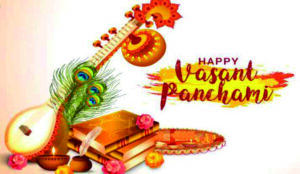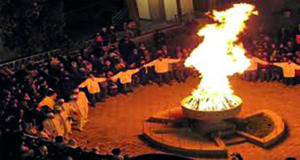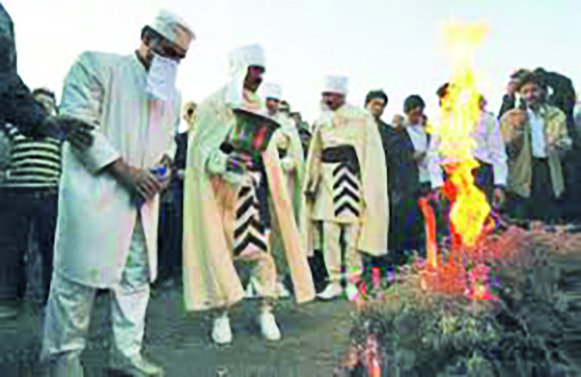 Though one may not feel the full impact of the cold in cities like Mumbai and much of costal peninsular India, it is actually mid-winter in the Northern hemisphere. While Iranian Zoroastrians just celebrated Jashn-e-Sadeh on 29th January, Hindus will celebrate Vasant Panchami on 2nd February, 2025. Both are mid-winter festivals and celebrate the oncoming spring season.
Though one may not feel the full impact of the cold in cities like Mumbai and much of costal peninsular India, it is actually mid-winter in the Northern hemisphere. While Iranian Zoroastrians just celebrated Jashn-e-Sadeh on 29th January, Hindus will celebrate Vasant Panchami on 2nd February, 2025. Both are mid-winter festivals and celebrate the oncoming spring season.
While Navruz and Mehergan celebrate the spring and autumn equinox (equal day and equal night) respectively in the Northern hemisphere, Tirngan and Yalda celebrate the summer (longest day) and winter (longest night) solstice. Jashan-e-Sadeh is not based on any celestial phenomena like the equinox or the solstice. In Iran, as per prevailing solar Jalali calendar, Jashn-e-Sadeh is celebrated forty days after Yalda, i.e. tenth day (Aban) of the month of Bahman (around 30th January of the Gregorian calendar). On account of leap year, this year Sadeh was observed on 29th January.
The Jalali calendar, also known as the Persian/Iranian calendar, is a solar calendar currently used in Islanic Iran and Afghanistan. It was developed in the eleventh century A.D., by a group of astronomers including Omar Khayyam (poet, mathematician, philosopher and astronomer), under the order of Sultan Jalaluddin Malik-Shah and hence the name Jalali. It is based on astronomical observations and begins on the vernal equinox (Navruz). In Iran, Afghanistan and various other central Asian countries, even non-Zoroastrians celebrate Navruz and other seasonal festivals as per the Jalali calendar.
The Zoroastrian Fasal (seasonal) or Fasli calendar was introduced in India by the renowned scholar, K. R. Cama, around the beginning of the twentieth century, with 21st March as the New Year and adding an extra day every four years called Ruz-i-Vahizak. The Fasal or Fasli calendar has not gained much popularity in India except for observing the Festival of Spring around 21st March every year. However, the Zoroastrian community in Iran and USA have largely embraced it and follow the seasonal calendar and the seasonal feasts like Mirangan and Tirangan at the appropriate time in nature.
 Sadeh has a complex history. Although this festival is mentioned in the Qissa-i Sanjan, the feast of Sadeh was virtually forgotten by the Parsis in India. Noted scholar Ervad Dr. Sir. Jivanji J Modi makes only a very brief note of it in his monumental work titled, ‘Religious Ceremonies and Customs of the Parsees’ (1922), dating this feast as Roj Ava, Mah Deh. Sadeh is discussed at length by Prof. Dr. Mary Boyce in her book, ‘A Persian Stronghold of Zoroastrianism’. She mentions a fire festival observed by Iranian Zoroastrians, which falls on the twenty sixth day (Astad) of the month of Azar or Adar in mid-December and which is one hundred days before Navruz. This festival is named Sada in Kerman and Hiromba in Yazd, and Boyce considers it to be more ancient than the Sada of the month of Bahman.
Sadeh has a complex history. Although this festival is mentioned in the Qissa-i Sanjan, the feast of Sadeh was virtually forgotten by the Parsis in India. Noted scholar Ervad Dr. Sir. Jivanji J Modi makes only a very brief note of it in his monumental work titled, ‘Religious Ceremonies and Customs of the Parsees’ (1922), dating this feast as Roj Ava, Mah Deh. Sadeh is discussed at length by Prof. Dr. Mary Boyce in her book, ‘A Persian Stronghold of Zoroastrianism’. She mentions a fire festival observed by Iranian Zoroastrians, which falls on the twenty sixth day (Astad) of the month of Azar or Adar in mid-December and which is one hundred days before Navruz. This festival is named Sada in Kerman and Hiromba in Yazd, and Boyce considers it to be more ancient than the Sada of the month of Bahman.
Observing The Feast Of Sadeh
Like Vasant Panchami this Iranian festival reminds people that Spring or Navroze is not too far away. Therefore, it is a festival that celebrates hope! Sadeh is a mid-winter festival to celebrate the earth slowly but surely warming up and the change in season ushering new life and warmth after the cold winter. Sadeh is celebrated by lighting huge bonfires after sunset just the way bonfires are lit after sunset on the festival of Holi in India. Lighting bonfires celebrates light over darkness and warmth over cold and life over death. To the blazing fires, Iranian’s say: “Sorkhie to az man, Zardieh man az to“, which is the devotee’s plea to the fire to bestow its red glow of heath and take away the devotee’s yellow pallor of illness!
According to legend, Sadeh also celebrates discovery of fire by Shah Hooshang of the pre-historic Peshdad dynasty. The festival is traditionally celebrated in Zoroastrian strongholds like Yazd and Kerman in open spaces with devout Zoroastrians dressed in white clothes gathering in large numbers with contributions of firewood for the fire and food to be shared and eaten together. The congregation also prays, sings and dances together as a community. The festival celebrates life, good health and strong community bonding.
The chief preparation for this ancient feast is the gathering of wood. Everyone in the community is expected to contribute a dried branch of wood and all those who contribute wood are considered as blessed by Ahura Mazda. The lighting of the community bonfire is preceded by an Afrinagan of Daham Yazata (a ceremony of blessing for the whole community), and Atash Niyayesh (fire litany).
Vasant Panchami
Vasant Panchami is a Hindu festival that reminds us that Spring and the festival of Holi is not too far away. Vasant means Spring and Panchami means fifth or the festival falling on the fifth day of the Hindu lunar month of Magha. It is considered an auspicious day to begin any new venture. On Vasant Panchami devotees usually wear yellow of saffron coloured clothes, offer yellow flowers while praying (especially before Saraswati – the Divinity of Knowledge and wisdom) and eat halva (a sweet dish) made with saffron which gives this dish a distinct saffron-yellow colour.
At this time of the year even agricultural fields are resplendent with yellow mustard flowers in bloom. Yellow is the colour of the sun, the sunflower and the mustard flower. It is mother Nature’s choice of colour ushering light and new life. While saffron is a sacred color in Hinduism, representing fire and the burning away of impurities, yellow is the color of knowledge, learning, happiness and peace. Lord Vishnu, Lord Krishna and Ganesha are traditionally depicted wearing yellow. On this day Surya – the yellow-golden sun is also thanked for bringing winter to an end with longer days and helping life to blossom once again after the cold winter.
Celebrating Creativity
Vasant Panchami is the festival dedicated to Saraswati the Divinity presiding over knowledge, language, music and all arts. Saraswati symbolizes creative energy and power in all its form, including love. Thus, this auspicious day celebrates creativity through knowledge, wisdom and love.
In the Zoroastrian tradition Avan is the equivalent of Saraswati. According to Zoroastrian theology, Avan is a purifying force and the bestower of life, knowledge and wisdom. Praying the Avan Niyaesh and the Avan Yasht regularly bestows the devotee with not just wisdom, but also the power to fight all forces of evil. Various Kings and Paladins of ancient Iran used to invoke Avan before going into battle.
May the pre-spring festivals of Vasant Panchami and Jashn-e-Sadeh usher new hope, new vigour and above all else bless all with knowledge and wisdom!
- In Search Of The Soul - 5 April2025
- Why Pray In A Language We Do Not Understand? - 29 March2025
- Celebrate Nature’s New Year With Purity And Piety of Ava - 22 March2025
